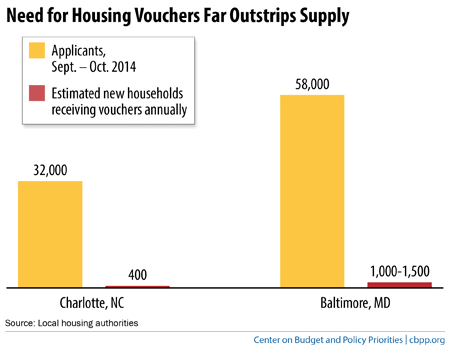BEYOND THE NUMBERS
Five local housing authorities that recently gave low-income residents their first chance in years to get on a waiting list for a Housing Choice Voucher received a flood of applications. This is further evidence that the need for affordable housing far outstrips the supply — and that federal voucher funding, squeezed by the sequestration cuts, is inadequate.
In Charlotte, which awards roughly 400 vouchers a year to new recipients as others leave the program, 32,000 applied for the waiting list (see chart). Baltimore, which awards roughly 1,000-1,500 new vouchers a year, had 58,000 applicants. Indianapolis had 45,000 applicants, Austin had 19,000, and the Chicago Housing Authority expects more than 250,000 applicants by the time the application window closes later this month.

Judging from the Charlotte applicants, roughly two-thirds of those seeking help are working families and one in seven are homeless. The Charlotte applicants also included more than 600 veterans.
Submitting an application doesn’t guarantee someone a place on the waiting list, let alone a voucher. Each housing agency will hold a lottery to choose which new applicants will make it to the waiting list; those lucky people may still have to wait many years for an actual voucher. While the lottery approach has drawn some criticism, the problem isn’t the lotteries — it’s the scarcity of vouchers.
Most housing agencies didn’t provide vouchers to any new families for the year after the sequestration budget cuts hit in March 2013; indeed, by March 2014, sequestration had caused the loss of some 90,000 vouchers nationwide. With the increased funding Congress provided for 2014, tens of thousands of new families will get help. But the House and Senate funding bills that Congress has considered for 2015 (but not yet enacted) would not allow further progress to restore sequestration cuts.
The outpouring of need is only the latest sign that the post-sequestration level of voucher assistance should not be acceptable. At a minimum, policymakers should restore all of the vouchers cut by sequestration to give more families a better chance of having a safe, stable home.
